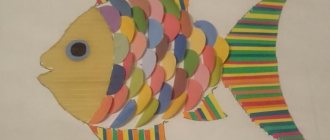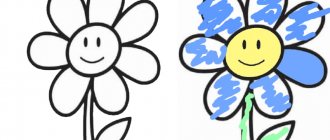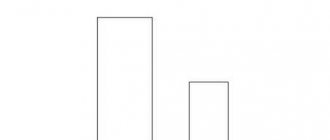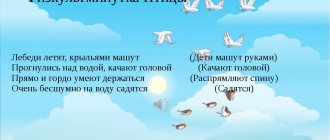Summary of the lesson on the application “Rug for dolls” Completed by teacher: Petrukhina O.A.
Target:
- teach children to cut narrow strips along the folds of paper into pieces;
- fold the strip twice to get four squares or rectangles;
- symmetrically arrange the pattern elements at the corners and sides of the square;
- distinguish between two shades of the same color.
Materials and equipment:
- flannelgraph and figures for laying out patterns;
- large squares and circles, small squares and rectangles;
- strips for demonstrating folding and cutting techniques;
- character Parsley;
- for children, sheets of paper 15x15 cm (for rectangles)
Some children have large figures and stripes of the same color, but in different shades (red and dark red, green and dark green, etc.).
Progress of the lesson:
A flannelgraph is placed in front of the children. Parsley appears: “Hello! What are you going to do?"
Educator: I want to show the children how to make a pattern of large and small squares on this rug.
Parsley: Can I try to make a pattern?
Educator: Try it, Parsley.
Parsley places the figures on the flannelgraph in disarray.
Educator: Children! Is this a pattern? No, Petrushka (removes the figures from the flannelgraph). The pattern will be obtained when the figures are located in certain sheets. Look, I will place identical squares in each corner of the rug. These are the big ones. And on the sides there are two small ones.
Parsley: Yes, it turned out beautifully! Can children make a pattern?
Educator: Children, who wants to help me make a pattern from other figures! Calls the child who wants it, gives him the mugs and asks where they can be placed on the rug (in the corners).
Parsley: Now I know where to place these little rectangles.
Educator: Where?
Parsley: On the sides of the rug. Here, here...
The teacher and the child make a pattern on the flannelgraph. Parsley looks at the children’s visual material and says: “But children cannot make such patterns. They don’t have little squares and rectangles.”
Educator: But they have stripes. They will fold them and cut them with scissors. Like this. First, fold the strip in half, then in half again, unfold it and cut it along the folds.
Bottom line.
We invite children to fold and cut the strips. He asks what kind of figures they got. Confirms that some children have small squares, while others have small rectangles. Then he offers to lay out a pattern of large and small figures on their sheets of paper. Those who did it correctly are allowed to stick on the pattern.
Author: Olesya Petrukhina
pedportal.net
Abstract of the GCD for the application for children of the second junior group “Rug for a cat”
Gulfina Iskuzhina
Notes on the application for children of the second junior group “Rug for a cat”
Goal: to teach how to independently compose patterns from geometric shapes.
Objectives: - learn to lay out a rug from geometric shapes;
- develop the ability to communicate with adults during the game;
- consolidate the names of geometric shapes, the ability to correctly pronounce their names.
— continue to introduce children to folklore works, cultivate a love for animals;
— consolidate previously acquired knowledge about the rules of gluing.
- looking at illustrations of a cat and kittens;
- introduction to geometric shapes and primary colors.
demonstration: toy cat , damaged rug .
handout: sheets of cardboard according to the number of children , ready-made geometric shapes, glue, brushes, napkins.
Applique striped rug medium gr | School files SchoolFiles.net
Municipal budgetary preschool educational institution “Child Development Center - Kindergarten No. 50 “Fidget” in the city of Novocheboksarsk, Chuvash Republic. Summary of continuous educational activities on the application “Striped rug for pets” (middle group) Compiled by teacher Natalya Nikolaevna Savinova. Novocheboksarsk - 2016. Program content: Teach children to create a harmonious composition “Striped rug” from paper strips alternating in color. Continue mastering the technique of straight cutting with scissors. Introduce a new method - cutting paper along fold lines. Develop a sense of color and rhythm. Develop independence and confidence. Equipment: paper rectangles as the basis for an applicative mat - one for each child (12x20), paper squares (8x8) of different colors - two colors for each child: for cutting into strips; scissors, glue, glue brushes, napkins, oilcloths. Two or three rugs - samples for showing children, pictures of animals. Move. V-l: Guys, who were we visiting today? (children's answers - at their grandmother's in the village) - Did your grandmother have many pets? (children's answers) - I noticed that none of the animals had rugs to lie down on. And now it's so cold. — Would you like to make rugs for pets? (children's answers) - What can rugs be made of? (Children express their guesses). Question: That's right, rugs can be made from fabric, wool, thread. - Look, I made rugs out of paper. — How are these rugs similar? Children's answers: the rugs are striped. — How do rugs differ from each other? Children's answers: by color, alternate in different ways in the pattern. — How do the stripes alternate? Children's answers: on one rug there is a green - yellow stripe, on the other there is a red - blue stripe, etc. V-l: Grandma gave us pictures of pets, now I suggest you choose the animal for whom your rug will be. Vl: And you and I will make beautiful striped rugs from paper. I invite you to the tables to make rugs for our animals. (Children sit down at the tables) Q: You already know how to cut paper into strips. For the rug we will need strips of the same width, so we will try to cut the paper in a new way: take a square, bend it in half, then in half again; smooth out the fold lines - from the middle in both directions; unfold and cut with scissors exactly along the fold lines - you get four strips; take a square of a different color and cut it into strips in the same way; and make a beautiful pattern - a stripe of one color, a stripe of another, etc. (the teacher accompanies his explanations with a demonstration of actions). Q: When your rugs are ready, you can glue a picture of an animal onto it. — And in order for our hands to work well, let’s play a game: Finger game “Kittens.” Our cat has de schoolfiles.net







